Types of printers
A printer is a technical device. The circulations it can cover are small - from 1 to 100 sheets. The first appeared in 1969 thanks to scientists who figured out how to make a well-known device with laser printing from a copy machine.
The content of the article
Classification of printers.
It can be classified according to several criteria:
- Based on the principle of image formation they are divided into three categories: sequential formation, which creates text character by character. Next come lowercase and page.
- By printing method They are divided into shock and unstressed.
- According to the color spectrum for colored ones and not.
- By type of material. There are:
- rolls equipped with winding;
- sheet intended for printing on film and paper;
- souvenir printers used for printing on disks, gadgets and for affixing stamps;
- allowing you to print three-dimensional forms of 3D devices.
- By type of ink used:
- alcoholic drinks that are not widely used;
- the most common solvent ones;
- oil used in industrial production;
- allowing to obtain high-resolution pigment images;
- UV-curable, which is an analogue of solvent ink.
- By purpose:
- wide-format, which are needed for outdoor advertising;
- interior, helping in interior design;
- photo printers for printing pictures;
- office;
- marking.
- Based on printing technology, they are divided into:
- matrix;
- jet;
- laser;
- LED (LED);
- shape-changing ink.
Important! The last classification is the main one, since most users pay attention to it. The most common types of devices, depending on the technology, are dot matrix, laser and inkjet printers.
Printer characteristics
The main characteristics include the following criteria:
- resolution - measured in the number of dye dots applied per inch of paper, the size of the smallest details;
- the number of colors that the finished image can convey;
- speed - the number of pages and characters that the device can print in one second or minute.
What are the different types of printers based on their operating principle, their advantages and disadvantages.
For rare use, most often purchased laser printers. They differ from others in their satisfactory speed, image quality and affordable price.
The operating principle of laser machines largely coincides with the operating principle of Xerox machines: using ink powder - toner. Text and pictures are first applied to the drum, after which they are transferred to sheets and baked using thermal units.
Important! The simplest laser printer prints from 10 to 20 pages per minute.
The benefits of use include:
- the possibility of not using the device for a long time during which the toner does not deteriorate or dry out;
- low cost of parts and consumables;
- resistance of the finished image to high temperatures and moisture;
- ease of operation;
- the fact that toner cartridges can be refilled yourself using compatible consumables.
Important! If the printer is blocked due to a lack of toner, you can reflash it or change the chip on the cartridge.
The disadvantages include:
- release of ozone, acetone and nitrogen oxide into the atmosphere during operation;
- presence of nodes with high power consumption;
- the possibility of breakage due to a misplaced paper clip or crumpled sheets;
- lack of stability in impressions.
A subtype of laser devices has become led printers, which differ from them in source. While laser devices have one beam, LED devices have a whole battery. They do not move; each point has its own light bulb.
The undeniable advantages include high speed and quality. The key disadvantage is considered to be high cost and low prevalence.
Laser devices can compete with inkjet printers. The image on the sheet consists of microscopic dots. There is a head inside the machine that applies liquid paint to paper sheets.
Important! These printers differ from each other in the type of ink used and speed.
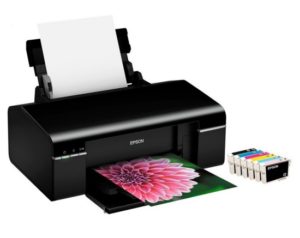 Inkjet devices are suitable for those who want to print high quality images. However, users need to take into account that liquid paints can dry out if left idle for a long time, and changing them is not that cheap. Previously, they used only 4 colors:
Inkjet devices are suitable for those who want to print high quality images. However, users need to take into account that liquid paints can dry out if left idle for a long time, and changing them is not that cheap. Previously, they used only 4 colors:
- yellow;
- blue;
- purple;
- black.
In modern models, two more colors were added, which made it possible to increase the brightness and saturation of the finished images. The advantages of inkjet devices include:
- price;
- quality of finished images;
- possibility of using photo paper;
- quiet operation;
- low power consumption during operation;
- the ability to print on different media;
- multifunctionality.
Among the disadvantages are high cost and slow speed. In addition, ink cartridges are much more expensive than, for example, color toner for a laser device.
Next in the ranking is matrix printer. For a long time it was used as a standard device that helps to transfer information from a computer to paper. Matrix devices were used even when laser and inkjet analogs had already appeared. They differed from them in their low price, but the image quality left much to be desired.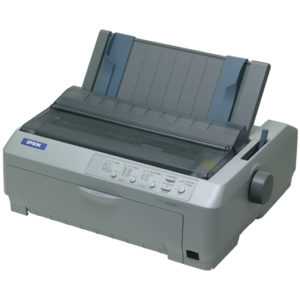
The advantages of such devices include:
- cheap consumables;
- ability to print on all types of paper;
- the ability to print on paper with a large number of layers.
Among the disadvantages are:
- that dot matrix printers print very slowly and loudly;
- that the quality of the images is very poor;
- that color printing is practically impossible.
Important! Most often, matrix devices are used for printing on forms.
3-D printers occupy a separate category of devices used for printing. Resembling a large box with glass allowing the process to be observed, they create shaped objects based on visual drawings.
During operation, the device uses ceramic powder, plastic threads and photopolymer resins, which, when combined gradually, layer by layer, create a given pattern.
Important! What could take a long time to create by hand can be quickly printed on a 3-D printer.
Devices that combine a number of functions deserve special attention: scanning, copying, printing photos and documents, receiving and sending faxes. That's what they call them - multifunctional devices or "MFP".Compact-sized MFPs are used for work in offices and at home, since combining the functions of several peripheral devices, they take up little space, operate quickly and are almost silent. The operating principle of the MFP is to use inkjet or laser technologies. You can also find LED MFPs in stores.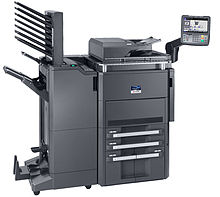
The advantages of using multifunctional devices include:
- low cost relative to purchasing each device separately;
- space saving;
- low cost of printing;
- the ability to simultaneously print on both sides of a paper sheet;
- high productivity;
- Possibility of printing photos on photo paper.
The disadvantages of MFPs include:
- the fact that if one of the nodes fails, the rest will not be able to work;
- low speed of copying paper documents;
- the fact that if the MFP fails, work can stop in the entire office.
In addition to the above types of printers, which differ in their operating principles, there are several other types. Some of them have already ceased to be in demand, and some are used only for certain purposes. Such machines include:
- Sublimation printers. Sublimation printers, characterized by a good level of color rendering and high quality, are used in printing houses.
- Drums. Drum printers were no longer used long ago due to the fact that when printing, letters were often located at different levels, “dancing” and “running” across the paper. The design of such machines was based on a drum with imprints of symbols, which, when rotating, left the necessary letters and numbers on the paper.
- Petalaceae. Another type of printer that has sunk into oblivion is the petal type. He printed using a flexible disk with petals located on it.During the work, the petals touched the tape with paint and paper, leaving certain marks on it.
Recommendations for selection
When planning to purchase a printer, you need to determine a few key points for yourself:
- The type of printer based on its operating principle and other criteria that is better than others for home or office use. For home use, it is recommended to purchase cheaper laser models; for offices, MFPs are suitable.
- The print format that covers the device. For students who work with A4 format, any of the printers described above will be suitable. It is necessary to specifically buy machines that could print text on A2 and A1 sheets only for work in offices and design bureaus.
- Print speed. Just like other criteria, the desired print speed depends on where and how the printer will be used. For your home, it is better to purchase a not very powerful and slow laser printer. For offices, it is necessary to buy high-torque and fast machines with high printing speed.
- Availability of additional functions. The possibility of double-sided printing, a display, connectors for USB cables and connectors for a card reader will greatly simplify use, but will also increase the price of the device by 2 or 3 times.
People who want to use types of printers to print educational materials and sometimes photographs should not purchase expensive models with high print quality and speed. Color inkjet printers, which are inexpensive and easy to maintain, are perfect for such needs. The main thing is not to forget to periodically drive the car to avoid allowing the paint to stagnate for long periods of time.

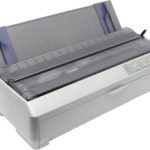
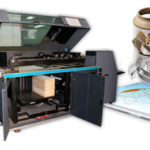
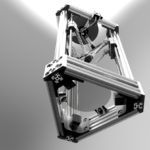

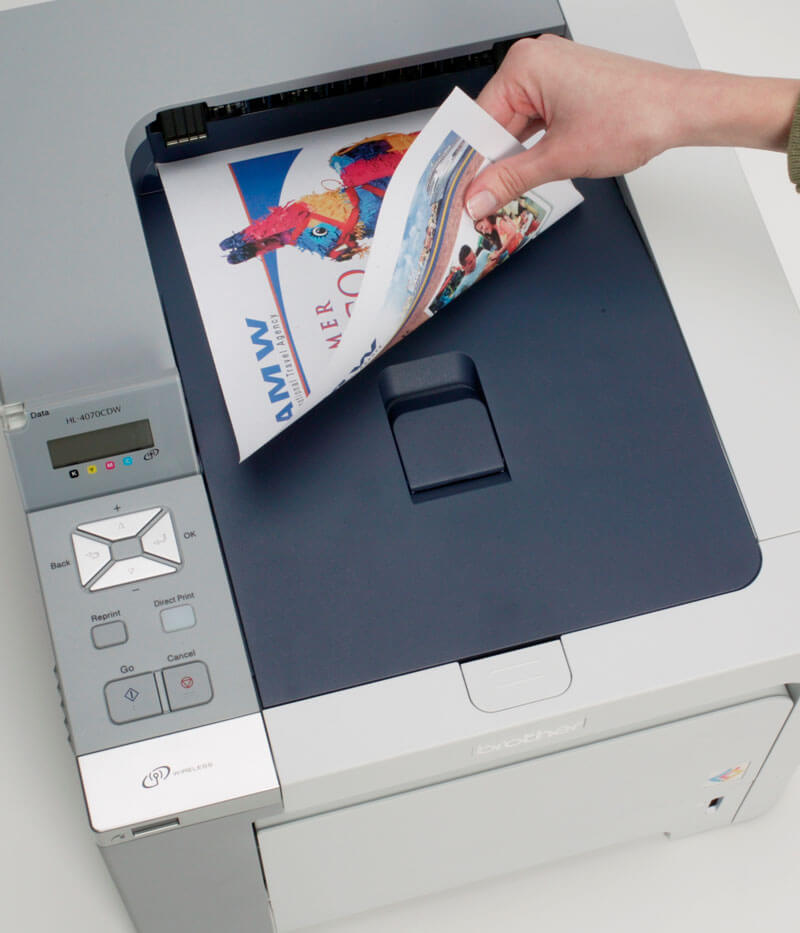
When operating the device, photopolymer resins, metal clay, ceramic powder and various types of plastic thread are used. The device, using one of these materials, gradually “increases” the 3D pattern.